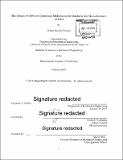| dc.contributor.advisor | Michael J Tarkanian. | en_US |
| dc.contributor.author | Peinado Estrada, Ruben. | en_US |
| dc.contributor.other | Massachusetts Institute of Technology. Department of Mechanical Engineering. | en_US |
| dc.date.accessioned | 2020-01-08T19:44:36Z | |
| dc.date.available | 2020-01-08T19:44:36Z | |
| dc.date.copyright | 2019 | en_US |
| dc.date.issued | 2019 | en_US |
| dc.identifier.uri | https://hdl.handle.net/1721.1/123426 | |
| dc.description | Thesis: S.B., Massachusetts Institute of Technology, Department of Mechanical Engineering, 2019 | en_US |
| dc.description | Cataloged from PDF version of thesis. | en_US |
| dc.description | Includes bibliographical references (page 35). | en_US |
| dc.description.abstract | The rate of heat extraction, hardness, and severity of quenching steel has been investigated using conventional and nonconventional methods. A variety of steel alloys such as 4140, D2, S7, and O1 were used in the preliminary tests with conventional quenching methods to observe the microstructures and hardness development. Results showed that as the cooling rate of the steel increase, the hardness of the steel increased. The microstructure of the conventional quenching methods were similar throughout the metal samples; air quenching produced larger grains of pearlite, ferrite, and cementite, oil quenching produced martensite and pearlite grains, and water quenching produced martensite. Afterwards, a further study was done with unconventional quenching methods on 1045 steel. The unconventional quenching methods that were studied included Olive Oil, Peanut Oil, Quench Fast, and Super Quench, quenchants which have been proliferated through blogs, online forums, and discussion boards. | en_US |
| dc.description.abstract | The results have shown that the unconventional quenching produces hardnesses greater than control samples. The quenching methods, however, within the range of 50 Vickers Hardness of each other, which is a small difference. Super Quench and water quench samples are within the standard deviation of their samples set from the hardness of each other similarly to Olive Oil and Quench Fast. Additionally the two groups of similar hardness had similar microstructures being composed of mainly martensite. It could be concluded that water and Olive Oil have the same effects as Super Quench and Quench Fast on 1045 steel respectively; therefore water and olive oil can be used as substitution providing a solution that are sustainable, nontoxic and quick to prepare. The metallurgical community has proliferated the use of unconventional quenching media as methods to yield superior results in steels. | en_US |
| dc.description.abstract | However, the results in this work show that the usage of different media rather than conventional quenching media, produce hardness and microstructures that are similar in value and composition. Therefore, there is no advantage to using quenching methods that have been advertised through blogs, online forums, and discussion boards. | en_US |
| dc.description.statementofresponsibility | by Ruben Peinado Estrada. | en_US |
| dc.format.extent | 35 pages | en_US |
| dc.language.iso | eng | en_US |
| dc.publisher | Massachusetts Institute of Technology | en_US |
| dc.rights | MIT theses are protected by copyright. They may be viewed, downloaded, or printed from this source but further reproduction or distribution in any format is prohibited without written permission. | en_US |
| dc.rights.uri | http://dspace.mit.edu/handle/1721.1/7582 | en_US |
| dc.subject | Mechanical Engineering. | en_US |
| dc.title | The effects of different quenching mediums on the hardness and microstructures of steel | en_US |
| dc.type | Thesis | en_US |
| dc.description.degree | S.B. | en_US |
| dc.contributor.department | Massachusetts Institute of Technology. Department of Mechanical Engineering | en_US |
| dc.identifier.oclc | 1135058498 | en_US |
| dc.description.collection | S.B. Massachusetts Institute of Technology, Department of Mechanical Engineering | en_US |
| dspace.imported | 2020-01-08T19:44:36Z | en_US |
| mit.thesis.degree | Bachelor | en_US |
| mit.thesis.department | MechE | en_US |
